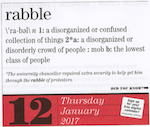|
Code Jockey posted:I really want one to stack on top of my laserdisc and betamax players just because I'm that guy, I guess. I missed a chance to get a CED player and a stack of movies off Craigslist a few years ago, and I still kind of regret it. They're not hard to find, you can have one whenever you want.
|
|
|
|

|
| # ? Apr 23, 2024 14:16 |
|
Dick Trauma posted:The Squier Strat I bought when I graduated high school (mid 1980s) had a crap connector and pickup switch that crackled and popped like mad even when it was brand new. I just figured it was due to being an entry level product. I quickly grew accustomed to fiddling with it each time I get it out of the case and it just became part of its "personality" but I don't think I'd tolerate that in any other piece of electronics. Anyway, here's some real retrocomputing:  That's a Post 1460 Versalog, a fairly late production log-log slide rule---this particular model was manufactured from 1960 to 1968. One of the interesting thing about slide rules of comparatively late vintage is how much thought and design work has obviously gone into them. Of course they're primitive computing devices by today's standards, but when you look at different specialised rules for e.g. different kinds of engineering you can see all the thought that's gone into the kind of workflow they expect the user to be doing. E.g. set the rule up to read the answer to a problem on one scale, and then be able to read the answer to a related problem off another scale without resetting the rule, that kind of thing.
|
|
|
|
SubG posted:Early to mid '80s Squier Strats were made in Japan and are the loving tits. My mid-80s MIJ Squier Strat has the best neck on any Strat or Strat clone I've ever played. After the mid '80s some were made in Japan and some were made in Korea, and the Korean Squiers had much spottier quality control than the MIJ ones. Someday I'll figure out how to use a sliderule. I have my father's on a shelf in my office. It makes it look like he was some kind of engineer, but in reality he used it to calculate interest rates or some poo poo.
|
|
|
|
SubG posted:Anyway, here's some real retrocomputing: The old-timer ex-NASA engineer at my workplace has one of those, he actually used it the other week since IT borked up his computer
|
|
|
|
Best slide rule:
|
|
|
|
Slide rules own. I learned to use my dad's when I was younger, but I've forgotten it all again.
|
|
|
|
Dick Trauma posted:The Squier Strat I bought when I graduated high school (mid 1980s) had a crap connector and pickup switch that crackled and popped like mad even when it was brand new. I just figured it was due to being an entry level product. I quickly grew accustomed to fiddling with it each time I get it out of the case and it just became part of its "personality" but I don't think I'd tolerate that in any other piece of electronics. My high school fat strat squier got stolen from me  Really lame because it was my first guitar and I had modded the pickups and it wasn't really worth anything to anybody else. Really lame because it was my first guitar and I had modded the pickups and it wasn't really worth anything to anybody else.It was the only guitar I had with a tremolo on it too so I've gotta get a new one at some point to replace it, been just playing on my les paul instead but I've got my eye on something with a floyd rose. SubG posted:Anyway, here's some real retrocomputing: Never forget that man went to space with this.
|
|
|
|
I know there's a way to use a regular folding ruler to calculate pipe bend angles somehow because I saw a dude do it once but gently caress if I can remember how he did it   e: Oh it was this trick. It wasn't as impressive as I remembered but actually very loving useful: https://www.youtube.com/watch?v=MqmDqBXQfvI 3D Megadoodoo has a new favorite as of 15:40 on May 19, 2015 |
|
|
|
Jerry Cotton posted:I know there's a way to use a regular folding ruler to calculate pipe bend angles somehow because I saw a dude do it once but gently caress if I can remember how he did it I love poo poo like this. Things that are
|
|
|
|
I've heard of using a certain length of string to find out if a door frame was built square. I just don't remember how it's done.
|
|
|
|
Star Man posted:I've heard of using a certain length of string to find out if a door frame was built square. I just don't remember how it's done. If it's just a single length, then going diagonally from corner to corner should be exactly the same if all the angles are 90 degrees.
|
|
|
|
flosofl posted:If it's just a single length, then going diagonally from corner to corner should be exactly the same if all the angles are 90 degrees. Right, the hypotenuse would be the same. I just don't know how you accurately make that measurement when the door frame is already built and all you have is a single length of string unless you have a twelve-foot armspan.
|
|
|
Star Man posted:Right, the hypotenuse would be the same. I just don't know how you accurately make that measurement when the door frame is already built and all you have is a single length of string unless you have a twelve-foot armspan. Tape? A push-pin? Finish nail?
|
|
|
|
|
Trap one end in one corner with your foot? A buddy?
|
|
|
|
derp
|
|
|
|
Star Man posted:Right, the hypotenuse would be the same. I just don't know how you accurately make that measurement when the door frame is already built and all you have is a single length of string unless you have a twelve-foot armspan. I wish I was high on potenuse!
|
|
|
|
Jerry Cotton posted:I know there's a way to use a regular folding ruler to calculate pipe bend angles somehow because I saw a dude do it once but gently caress if I can remember how he did it I figured he was building up to "and then use trig to calculate the angle based on the known lengths" but nope, it was just "and then later you can bend it back to the same value once you've climbed down the ladder" Still, I've always wondered what those sectional rulers were for, now I know. Or you could carry a compass?
|
|
|
|
Phanatic posted:Best slide rule:  Zaphod42 posted:Never forget that man went to space with this.  The Post Versalog in my first post is bamboo, which makes a remarkably nice slide rule---the wood is very dimensionally stable (so it doesn't get harder to use if it's humid or very hot or cold). Pickett's rules are almost all made of aluminium, which is presumably something NASA found attractive. This made very good ad copy for Pickett at the time---there were special edition boxes for Pickett N600s mentioning that they were used on the Moon and that kind of thing. Since we're talking about retrocomputing used in space flight I could get some pics of my old HP-41CX, which was used as a backup on the STS missions, and a Soviet Elektronika MK-52, which was the backup on Soyuz (and also RPN!).
|
|
|
|
 I love poo poo like this. Pictured is the Norden bombsight, used by the air force in WW2. It was a mechanical computer which would adjust for bomb trajectory based on changing flight conditions and also patched into the plane's autopilot and allowed for bombing far, far more accurate than the carpet bombing that was necessary before it. Its design is compared to the Manhattan Project in secrecy and scale. Before this bombers had to use a slide rule to calculate trajectory themselves using a simple sight. But it allowed for automatic calculation, not unlike modern digital fighter pilot systems. But entirely analog.  The real deal. They've been replaced by processors and circuits which can do the same in a fraction of the size, but there's something really elegant about such a well oiled mechanical machine. Zaphod42 has a new favorite as of 22:44 on May 19, 2015 |
|
|
|
Zaphod42 posted:Pictured is the Norden bombsight, used by the air force in WW2. It was a mechanical computer which would adjust for bomb trajectory based on changing flight conditions and also patched into the plane's autopilot and allowed for bombing far, far more accurate than the carpet bombing that was necessary before it. That was the marketing-speak, anyway. In reality, the Norden was nowhere near accurate enough for precision bombing, and claims that it could drop a bomb right into a pickle-barrel were grotesquely overblown. Under actual combat conditions, the CEP (the radius from the target within which 50% of the bombs will fall) was roughly a quarter of a mile; carpet-bombing was still a necessity. Zaphod42 posted:They've been replaced by processors and circuits which can do the same in a fraction of the size, but there's something really elegant about such a well oiled mechanical machine. You'll love this, then: https://www.youtube.com/watch?v=s1i-dnAH9Y4 Phanatic has a new favorite as of 23:58 on May 19, 2015 |
|
|
|
SubG posted:The slide rule that most Apollo missions carried was a Pickett N600-ES, a 6" pocket rule: I've got the full-sized version of that Pickett. The aluminium has a tendency to bind slightly sometimes, but otherwise it's extremely nice to use. I also have a K&E Log-Log model of some sort, can't remember exactly which. fake edit: forgot, I have it in my desk drawer, it's a K&E 68 1210 (http://americanhistory.si.edu/collections/search/object/nmah_1214627). The case it came with is loving mint because the previous owner bought it brand new the same year the first decent scientific calculator came out; he was an engineering student and quickly shelved the slide rule in favor of a calculator.
|
|
|
|
Pham Nuwen posted:I've got the full-sized version of that Pickett. Pham Nuwen posted:fake edit: forgot, I have it in my desk drawer, it's a K&E 68 1210 (http://americanhistory.si.edu/collections/search/object/nmah_1214627). The case it came with is loving mint because the previous owner bought it brand new the same year the first decent scientific calculator came out; he was an engineering student and quickly shelved the slide rule in favor of a calculator. I just love poo poo like that. Designing slide rules was a legitimately big and important problem for a lot of years, and there's a gently caress of a lot to be learned about design in general by looking at elegant solutions for problems that, to you, are completely foreign and possibly useless. Speaking of which, here's a few handheld calculators. These are all HPs:  In the upper left is an HP-15C, one of the best scientific calculators ever made. Even leaving aside poo poo like durability (the things are practically indestructible), low power use (a couple of watch batteries keeps one going for years of daily use), and form factor (specifically designed to fit into the lead designer's shirt pocket) you could learn a graduate class' worth of algorithm design and computer math from reading the design documents and their discussion. Getting ten digit precision out of a quick trig function that you can implement in that hardware is a nontrivial problem, and the 15C does it arguably as well as any device ever has. Below the 15C and looking superficially almost identical to it is a HP-16C. An odd beast, it was designed specifically for computer programmers. It does poo poo like base conversion, unsigned one's compliment and two's compliment binary, lets you set the word size, register shifting/rotating, masking, bitwise logical operations, and that kind of thing. Of course any computer you're programming will also do that kind of thing, but this was back in the day when the window you were typing into was the only window you had, as a general rule. The bigger guy there is an HP-41CX. It's at the ragged edge between calculator and handheld computer. The display isn't a standard 7-segment LCD, it has an unusual 14-segment display to allow for full alphanumeric support. The rear panel (not the underside---the `top' that's facing away from the camera) had four slots for expansion cards. Most of the cards added additional functions---programs, additional functions, and so on geared for specific tasks---specific scientific or engineering fields, that kind of thing. There was also a plugin card that added support for HP-IL (the HP Interface Loop), which was a sort of precursor to USB. It allowed you to connect the 41C directly to any other device that also had an HP-IL interface. There were things like HP-IL printer interfaces, but also things like disc drives, as well as various kinds of scientific and engineering instruments (volt meters, gas chromatographs, surveying equipment) to allow automatic data collection and storage, as well as letting the calculator function as a control device for everything. This is all poo poo that's completely boring everyday poo poo today, but the HP-41 series was introduced in 1979---it's roughly contemporaneous with the Atari 2600 and the TRS-80 Model I. There's a 41CX in the Smithsonian that was carried as a backup on several Space Shuttle missions. The CX actually has a number of features that were added specifically to meet NASA's specs---the original 41C lacked an internal clock, for example, which NASA wanted. And this guy (this model, not this individual one), the Elektronika MK52 (sitting on the wiring diagram that was included with each one), was used as a backup on the Soyuz:  The bumps along the back edge of the calculator are removable covers for expansion slots. Like the 41C, the MK52 accepted expansion modules that added functions, features, and that kind of thing. One available for the MK52 was specifically designed for handling re-entry for a Soyuz that had lost its onboard computer. One of the other interesting things about the MK52 is that it is the only handheld calculator to feature onboard programmable EEPROM for nonvolatile storage. One of the switches under the display (next to the power switch) switches the calculator into EEPROM programming mode, in which you can write programs which the calculator will remember even if the batteries are removed. In addition to the documented features, the MK52 (and Elektronika calculators in general) have enough undocumented features that I could spend the rest of the day describing them. It has the interesting feature that it will display an error message whenever it gets a result it can't display, but it will quite happily retain the result internally and allow you to continue to perform operations on it. Since the machine internally understands and will execute all kinds of binary operations it can't actually display (almost as many as the HP-16C has) and it can internally handle numbers larger than it can display, this means you can find yourself storing multiple errors in different memory locations and performing operations on them and getting the answer you were looking for.
|
|
|
|
Brilliant post, SubG. I love old calculators; I have a sizeable collection of random old units that I kept in my old office (sadly they now live in boxes as I have nowhere else to keep them). One that I've always wanted is a HP 12C. They still make them, but they're too expensive for me to justify buying as just a novelty. The best bit of trivia about these is that in the 80s when they switched to an integrated circuit, they figured that users would be less likely to trust an answer that was given without delay. So they always under-clocked the processors so they'd have just a bit of delay.
|
|
|
|
Krispy Kareem posted:Someday I'll figure out how to use a sliderule. I have my father's on a shelf in my office. The standard slide rule (as opposed to the single-purpose ones like the nuke yield calculator) does multiplication/division, and square/cube roots. Here's a beginner's guide on how to use one. My dad spent a solid week in high school math class learning how to use a slide rule. I had a TI-83, and cheated on tests by putting plaintext cheat notes into it as programs  . .I have a few:  Aluminum 10" Pickett 1010ES, bamboo 6" Post 1444K, and stainless steel Seiko Chronograph with a modified E6B on the bezel. The vintage ones are just cool collectibles to play with, but I actually use the one on my wristwatch sometimes. Though for anything requiring actual precision I fire up the TI-83 emulator on my phone. SubG posted:Speaking of which, here's a few handheld calculators. These are all HPs
|
|
|
|
Tubesock Holocaust posted:Fixed. I don't know what the gently caress I was thinking. My first thumb drive was a 4MB see thru Lexar drive. I thought it was the bees knees. It still works too.
|
|
|
|
Code Jockey posted:Maaaaan I want SGI hardware so bad. I keep trawling local craigslist for it, but no dice. A BeBox and a NeXT Station would be the the tits.
|
|
|
|
b0nes posted:My first thumb drive was a 4MB see thru Lexar drive. I thought it was the bees knees. It still works too. One thing I forgot to mention was that mine stopped working a few months after I bought it. Since then, I've owned over a dozen thumb drives and haven't had a single one fail on me. I always wanted to learn how to use a slide rule, but being incredibly math-adverse puts a wrench into that idea.
|
|
|
|
b0nes posted:There is/was a dedicated site where you could buy working SGI and SUN hardware and have it shipped. I'll look it up if you really want one. I want an 02 or an Indy. Ooo that'd be cool and I'd appreciate it, thanks!
|
|
|
|
Speaking of old calculators, I'm surprised nobody's mentioned the Curta yet. I've wanted to get a Type 1 and a Type 2 for a few years now. There's just something that I find really cool about a mechanical calculator that fits in the palm of your hand. There's a site here that has manuals and a flash simulator for it.
|
|
|
|
At the intersection of mechanical computers and calculators we have... mechanical calculators! One of these days I'm going to buy myself one of these beauties. I mean wow, that's just awesome, isn't it? A "number mill" is such a fun concept. Its like a miniature version of Babbage's computation engine. Phanatic posted:That was the marketing-speak, anyway. In reality, the Norden was nowhere near accurate enough for precision bombing, and claims that it could drop a bomb right into a pickle-barrel were grotesquely overblown. Under actual combat conditions, the CEP (the radius from the target within which 50% of the bombs will fall) was roughly a quarter of a mile; carpet-bombing was still a necessity.
|
|
|
|
C.M. Kruger posted:Speaking of old calculators, I'm surprised nobody's mentioned the Curta yet. I've wanted to get a Type 1 and a Type 2 for a few years now. There's just something that I find really cool about a mechanical calculator that fits in the palm of your hand. There's a site here that has manuals and a flash simulator for it. Perhaps inevitably, everyone always tried to take their Curta apart to see how it worked, only to have it come apart into springs and rods. It was impossible to reassemble without specialized jigs, so the company considered the "real" price of their Calculators to include the cost of sending it back for repair that first time.
|
|
|
|
Zaphod42 posted:At the intersection of mechanical computers and calculators we have... mechanical calculators! https://www.youtube.com/watch?v=qKm9eM2BuM0 This guy also has a video showing some of the steps in restoring this beast to working order. Basically, inside the casing it's one solid block of cams and levers. Also, a few months ago I looked at Curtas on eBay. They go for upwards of 1000€.
|
|
|
|
SubG posted:The bigger guy there is an HP-41CX. It's at the ragged edge between calculator and handheld computer. The display isn't a standard 7-segment LCD, it has an unusual 14-segment display to allow for full alphanumeric support. The rear panel (not the underside---the `top' that's facing away from the camera) had four slots for expansion cards. Most of the cards added additional functions---programs, additional functions, and so on geared for specific tasks---specific scientific or engineering fields, that kind of thing. There was also a plugin card that added support for HP-IL (the HP Interface Loop), which was a sort of precursor to USB. It allowed you to connect the 41C directly to any other device that also had an HP-IL interface. There were things like HP-IL printer interfaces, but also things like disc drives, as well as various kinds of scientific and engineering instruments (volt meters, gas chromatographs, surveying equipment) to allow automatic data collection and storage, as well as letting the calculator function as a control device for everything. This is all poo poo that's completely boring everyday poo poo today, but the HP-41 series was introduced in 1979---it's roughly contemporaneous with the Atari 2600 and the TRS-80 Model I. I always like to whip this video out. http://www.eevblog.com/2014/02/18/eevblog-582-hp41cv-calculator-teardown/
|
|
|
|
Capn Jobe posted:Brilliant post, SubG. I love old calculators; I have a sizeable collection of random old units that I kept in my old office (sadly they now live in boxes as I have nowhere else to keep them). My mom still has a 12C. Never uses it, gets mad if I so much as move it while trying to find something else in that drawer.
|
|
|
|
Capn Jobe posted:One that I've always wanted is a HP 12C. They still make them, but they're too expensive for me to justify buying as just a novelty. The best bit of trivia about these is that in the 80s when they switched to an integrated circuit, they figured that users would be less likely to trust an answer that was given without delay. So they always under-clocked the processors so they'd have just a bit of delay. Get the HP-15C instead unless you're an accountant. I have a 12C and it's sorta financially-focused. I mostly use my HP-48, though.
|
|
|
|
Pham Nuwen posted:I mostly use my HP-48, though. RPN is so clearly better. It's basically functional programming and allows more natural breakdown of operations. It's why I can still understand some of the math I learned a long time ago.
|
|
|
|
An HP BAII+ got me through four years of a finance degree. Everyone else was fiddling with their Texas Instruments Trying to figure out how to calculate interest and I was pretty much solving world peace with the functionality this thing had. It had an instruction manual that was thicker than some of my textbooks and more informative than most of the rest. It's a drat shame that I lost it after graduating...I guess it was too good for this world. In an era where excel exists I just can't justify spending $150 on the "professional" HP calculator.
|
|
|
|
Phanatic posted:Best slide rule: All I can see is obsolete copy protection. 
|
|
|
|
Pope Guilty posted:All I can see is obsolete copy protection. I wish we still had these. I miss them. At least they don't rootkit the gently caress out of your PC, though whoops if you lose it I suppose!
|
|
|
|

|
| # ? Apr 23, 2024 14:16 |
|
Code Jockey posted:I wish we still had these. I miss them. Does that still happen? I thought (hoped) that Starforce and its ilk were obsolete and failed technology.
|
|
|




























 Bad Angus! Bad!
Bad Angus! Bad!










